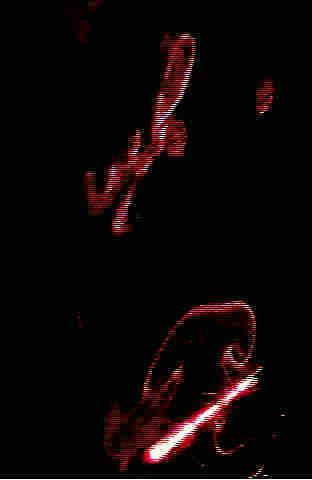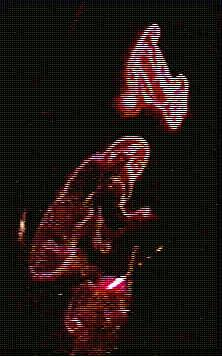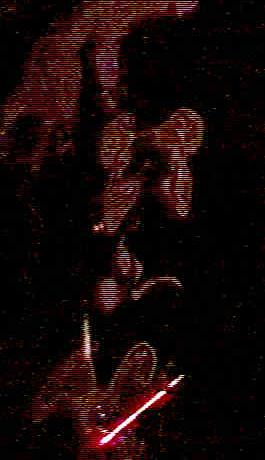A Thin Slice of Steam | ||
|
Copyright (C) 2004
|
With the lights out, the reflections in the steam are more visible. I
used a camcorder to record the images, then ran some picture frames
through my SGI Indy workstation, enhancing the contrast a bit. With a modern digital camera, your pictues should be far better than these.

The top puff has already convoluted itself many times. Below it, you can see how the cross section of a puff becomes a mushroom form as it leaves the mouth of the teapot. The mushroom forms as the steam around the edges of the puff is slowed by the still air, causing it to swirl and mix, while steam in the center moves upwards faster. As you try your own experiments, you will note that the reflections forming the image appear stronger as you approach the plane of the beam. Can your figure out why?

At the top, one puff has curled in to confusion as the edges of the puff were held back by the static air the steam is passing through. In the middle of the picture, the edges of our mushroom are still somewhat clear, but you can see the mixing that takes place as the edges curl in on themselves. This is typical chaotic behavior. Now, it almost looks like a monkey. At the mouth off the teapot, we can see another puff of steam just starting out.

With all the folding and mixing going on as the puffs move, steam can form strange patterns. Who knows what this third image looks like! It's more like a Rorschach ink blot test. Images like this are great for stimulating the imagination. Can you see the woman in the upper part of the picture? She seems to be reaching down to the twin forms, (infants?) floating in the middle of the picture. Or maybe it's something else. A pair of heads? Who knows! Each of us may see different things. Often, while looking at random patterns, be it steam, gains of salt tossed on a black background, or stars in the sky, we seem to be able to "find" things we recognize. This is because our ancestors spent a lot of time trying to see what animals might be hiding in the bushes. Or at least those who became our ancestors did... Those who failed to see the lion or tiger often didn't live long enough to have many children. So it was better to occasionally see something that wasn't there, than not see what was. I am interested in how the brain works, and have experimented with some neural network simulation programs and similar things. Other ExperimentsWhat do you think the effects would be of a differently shaped "throat" to the tea pot? What similarities would this have with rocket engines? How do you think the puffs would look if you scanned the laser beam horizontally across the steam puffs? How would it change at different heighs? What safety precautions would you have to take to keep the laser beam from scanning across your eyes when you did this? Although we used a laser beam for this experiment, do you really need to use a laser beam? Can you think of another way of providing a thin layer of illumination so that you don't have to use a laser? Let's take a look at the subject of Imagination and "Ancient Egyptian Steam Readings" next. | |